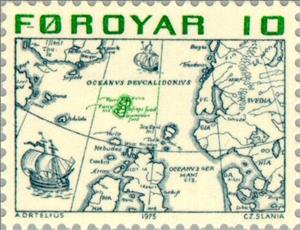Stamp: Map of Northern Europe by Abraham Ortelius (1527-1598) (Faroe Islands 1975)
Map of Northern Europe by Abraham Ortelius (1527-1598) (Faroe Islands 1975)
30 January (Faroe Islands ) within release Maps and landscapes goes into circulation Stamp Map of Northern Europe by Abraham Ortelius (1527-1598) face value 10 Faroese oyra
| Stamp Map of Northern Europe by Abraham Ortelius (1527-1598) in catalogues | |
|---|---|
| Michel: | Mi:FO 8 |
Stamp is horizontal format.
Also in the issue Maps and landscapes:
- Stamp - Map of Faroe Islands 1673 face value 5;
- Stamp - Map of Northern Europe by Abraham Ortelius (1527-1598) face value 10;
- Stamp - Map of Faroe Islands 1673 face value 50;
- Stamp - Map of Northern Europe by Abraham Ortelius (1527-1598) face value 60;
- Stamp - Island of Sandoy Westcoast face value 70;
- Stamp - Map of Northern Europe by Abraham Ortelius (1527-1598) face value 80;
- Stamp - Map of Faroe Islands 1673 face value 90;
- Stamp - Map of Northern Europe by Abraham Ortelius (1527-1598) face value 120;
- Stamp - Island of Sandoy Westcoast face value 200;
- Stamp - Islands of Streymoy and Vágar face value 250;
- Stamp - Islands of Streymoy and Vágar face value 300;
- Stamp - Islands Vidoy and Svinøy, painting of Eyvindur Mohr face value 350;
- Stamp - Village Nes, painting by Ruth Smith (1913-1958) face value 450;
- Stamp - Headland Skálafjørður, painting of Samuel Joensen-Mikines face value 500;
- First Day Cover - Map of Faroe Islands 1673 face value 145;
- First Day Cover - Map of Northern Europe by Abraham Ortelius (1527-1598) face value 270;
- First Day Cover - Island of Sandoy Westcoast face value 270;
- First Day Cover - Islands of Streymoy and Vágar face value 550;
- Booklet - Maps and landscapes face value 2;
Stamp Map of Northern Europe by Abraham Ortelius (1527-1598) it reflects the thematic directions:
Cartography (/kɑːrˈtɒɡrəfi/; from Ancient Greek: χάρτης chartēs, 'papyrus, sheet of paper, map'; and γράφειν graphein, 'write') is the study and practice of making and using maps. Combining science, aesthetics and technique, cartography builds on the premise that reality (or an imagined reality) can be modeled in ways that communicate spatial information effectively.
A map is a symbolic depiction emphasizing relationships between elements of some space, such as objects, regions, or themes. Many maps are static, fixed to paper or some other durable medium, while others are dynamic or interactive. Although most commonly used to depict geography, maps may represent any space, real or imagined, without regard to context or scale, such as in brain mapping, DNA mapping, or computer network topology mapping. The space being mapped may be two dimensional, such as the surface of the earth, three dimensional, such as the interior of the earth, or even more abstract spaces of any dimension, such as arise in modeling phenomena having many independent variables. Although the earliest maps known are of the heavens, geographic maps of territory have a very long tradition and exist from ancient times. The word "map" comes from the medieval Latin Mappa mundi, wherein mappa meant napkin or cloth and mundi the world. Thus, "map" became the shortened term referring to a two-dimensional representation of the surface of the world.


